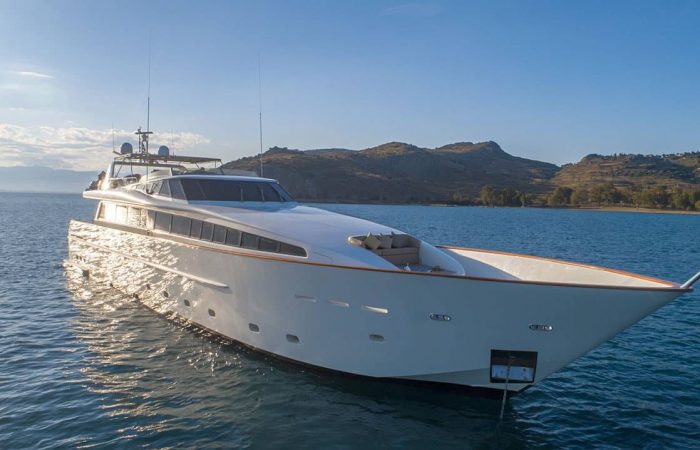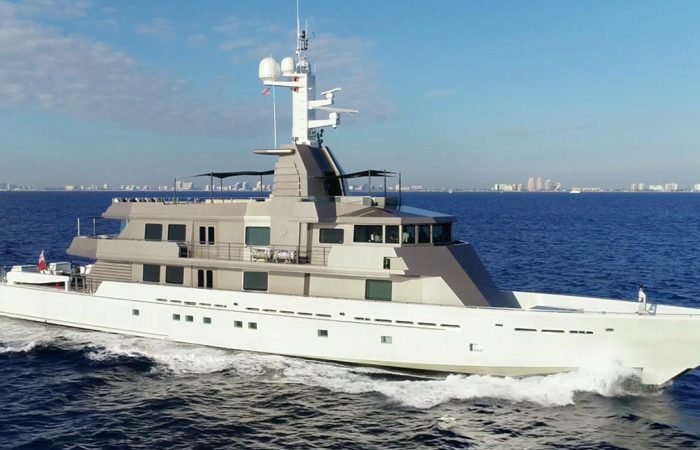Innovo Yacht
Υacht interior Renovation & Design
about us
Innovo Yacht interior Renovation
With unwavering dedication, our company has steadily grown over the years, establishing itself in the field of yacht and megayacht services in Greece. Today, we take immense pride in our scope and unwavering commitment for Υacht interior Renovation to serving the unique needs of the yachting community.
Our team is always at your disposal. Learn more about how we can assist you.
Design
Design & Renovation by InnovoYacht
The InnovoYacht is a recognized company of yacht designers and naval architects in Greece,proposing an innovative, contemporary, and sustainable approach.
We ensure that construction is carried out in accordance with design standards and quality requirements with scheduled visits from our experts.
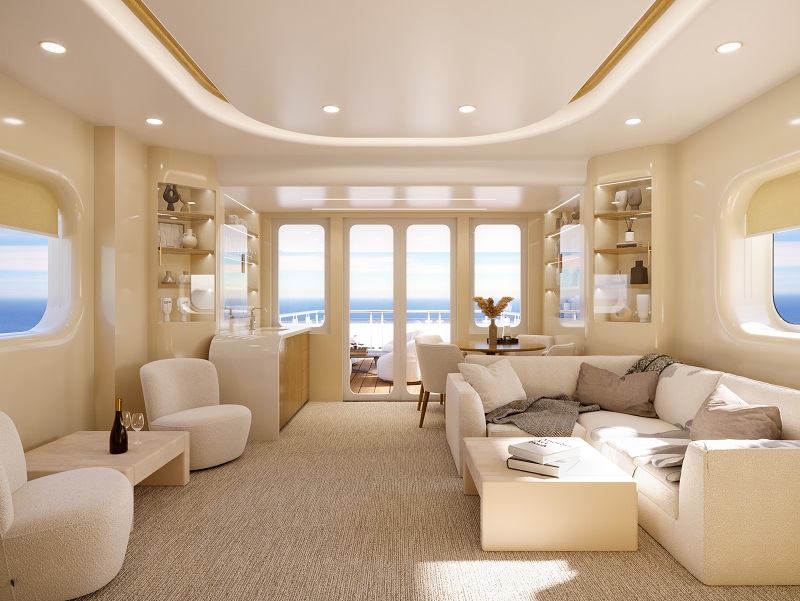
Yacht Interior Renovation – 3D Designs
We firmly believe that a detailed and carefully developed study is essential for the success of the project.
Firstly, however, we must determine the style preferred by the owner. This is achieved by discussing various interior details and design influences to quickly clarify an aesthetic direction. It is crucial at this stage to interpret the client’s requirements as accurately as possible.
From initial sketches and material selections, we then develop three-dimensional computer models of all interior spaces. This provides the client with realistic images of the concept of the boat’s Υacht interior Renovation.
The 3D designs meticulously depict the internal perspectives and include lighting arrangements and built-in furniture. Additionally, we provide typical construction details and sections through architectural elements such as doors and molds.
Original designs for custom-made furniture are prepared.
Interior designers maintain close contact with the builders throughout the construction process.
Exterior Design and Υacht interior Renovation
The development of the external “style” of a yacht is a complex process that requires the incorporation of all technical and regulatory requirements, as well as addressing the demanding needs of the boat’s interior.
The exterior style must be developed in parallel with the overall design. The process of exterior design begins with the development of the idea. Our team then produces a detailed three-dimensional computer-generated model from which the shipyard can obtain precise design information. It includes details about the external decking, fixed furniture, dining areas, and all external parts of the boat.
Yacht designers, Athens Greece.
Trends in Yacht Interior Design
Exploring the Fusion of Tradition and Innovation in Custom Υacht interior Renovation: Trends for 2024
In the realm of custom sailing yacht interiors in Greece, there exists a fascinating irony: while contemporary designs draw inspiration from the past, they intertwine with modern ingenuity to create spaces that are both nostalgic and innovative.
Embracing Simplicity and Natural Elements: Yacht designs that prioritize simplicity, balance, and the use of natural materials have stood the test of time. However, in 2024, there’s a fresh perspective that strikes a harmonious balance between traditional elements and modern aesthetics, resulting in captivating interior spaces.
Amplified Connection with Nature: An emerging trend is the integration of larger windows, fostering a seamless connection between the yacht’s interior design and the breathtaking outdoor vistas. Yacht owners increasingly seek unobstructed views of the surrounding environment, while inviting abundant natural light to flood their living quarters.
Robust Glass Innovations: To accommodate expansive windows in the challenging marine environment, designers employ advanced glass materials like tempered or laminated glass with multiple layers. These high-strength materials withstand the rigors of wind, waves, and potential impact from marine elements, ensuring both durability and aesthetics.
Ingenious Engineering Solutions: Innovative engineering techniques play a pivotal role in maximizing the size and placement of windows. Lightweight structural materials such as carbon fiber and titanium enhance the yacht’s construction, enabling the incorporation of larger windows without compromising structural integrity.
These trends not only elevate the aesthetic appeal of sailing yacht interiors but also enhance the overall seafaring experience, bridging the gap between tradition and modernity in captivating ways.
Multi-Functionality and Flex Spaces for Υacht interior Renovation
As owners spend increasingly more time aboard their yachts, the demand for versatile spaces has surged. Yacht interiors in Greece, now accommodate home offices, fitness centers, gourmet kitchens, and communal areas for extended social gatherings.
Designers ingeniously maximize space by crafting multi-functional areas that seamlessly transition between different purposes. From convertible seating areas to dining tables that double as extra seating, clever storage solutions optimize every inch of available space.
Spirit of Tradition
Yacht designers pay homage to heritage and history while infusing modern sensibilities into their creations. Evoking nostalgia without veering into cliché territory, the Spirit of Tradition yacht design ethos embodies a timeless allure. Rooted in historical aesthetics, these designs incorporate elements reminiscent of bygone eras, particularly evident in the hull and superstructure forms.
However, adherence to tradition doesn’t preclude embracing contemporary advancements in materials, construction techniques, and naval architecture. It’s the harmonious fusion of tradition and modernity that defines the essence of Spirit of Tradition yacht designs, ensuring a timeless appeal with a nod to the future.
Natural Material
Yacht owners, inherently drawn to water’s embrace and the wonders of the natural world, naturally gravitate towards incorporating organic elements like wood, stone, and other earthy materials into their yatch’s design. These elements not only infuse warmth but also forge a harmonious link between the interior spaces and their marine surroundings.
With our expertise in wooden boat design, we’ve long extolled the virtues of timber for structural integrity. Yet, there’s a burgeoning interest among owners in embracing hardwoods and sustainable timbers, driven by a desire to fulfill aesthetic, durability, and eco-conscious objectives in yacht interior design.
In addition to timber, natural materials such as leather and wool are making their mark, adding tactile richness and comfort to yacht interiors. Not only do these finishes exude beauty, but they also boast resilience, standing up admirably to the rigors of the marine environment.
Renovation
While restomods have long been celebrated in the realm of classic cars, their emergence in the yachting world is a more recent phenomenon. However, the tide is turning, with numerous success stories showcasing the potential of yacht restomods.
These transformations offer a cost-effective solution for owners seeking to preserve sentimental connections to their vessels while enjoying bespoke, customized spaces that often prove more economical than new custom builds. They’re particularly appealing to those inheriting family boats, as they provide an opportunity to enhance utility and comfort for future generations.
Historical yacht interiors, while rich in charm, may lack the modern ergonomics and amenities desired by today’s owners. A well-executed restoration project strikes a delicate balance, preserving the original design’s charm and character while enhancing comfort and livability.
Upgrades to electrical systems, electronics, navigation, plumbing, and propulsion systems are typically straightforward, providing immediate benefits. When it comes to interior design, a thoughtful approach is paramount, ensuring that updates complement the vessel’s original character while elevating comfort, functionality, and aesthetics.
Optimizing Space with Flexible Crew Cabins
Balancing the desire for a spacious vessel with the practicalities of managing size and cost can be a challenge for yacht owners. As we age, the responsibilities of skippering our own yacht may detract from the enjoyment of cruising. While hiring crew can alleviate operational burdens, it also entails sharing interior space.
Flexible crew cabins offer a cost-effective solution to optimize space utilization based on crew presence. Installing pocket doors in sleeping quarters allows seamless conversion of private berths into expansive main salon areas when doors are open, and reverts to private rooms for guests and crew as needed. This versatile approach maximizes onboard space efficiency, enhancing both comfort and functionality.
Smart technology
Yacht owners in Greece are showing a growing interest in integrating smart technology into their yatchs, encompassing lighting, climate control, entertainment systems, and security features that offer remote control capabilities. Smart technology empowers owners to manage onboard environments efficiently, optimizing energy consumption while enhancing comfort. Moreover, it adds an additional layer of security by enabling remote monitoring of the yacht, providing peace of mind even when far from the vessel.
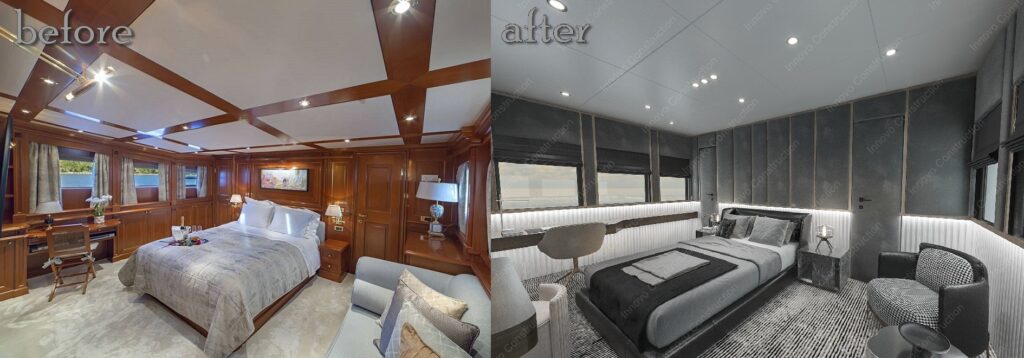
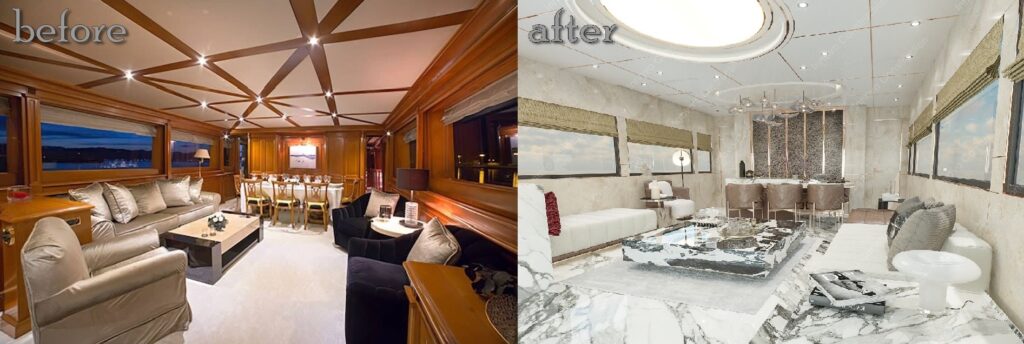
InnovoYacht | Athens, Peraeus, Greece
Yatch Design for 2024
Join us as we delve into the cutting-edge trends shaping yacht design this year. From innovative folding transoms and luxurious “floating beach clubs” to the exhilarating concept of kite-powered mega yachts, we’ll explore the top five coolest and most thrilling design themes of the year.
Wellness and an active lifestyle
The global pandemic has heightened awareness of mental and physical well-being on a global scale. According to Precedence Research, the wellness tourism market is projected to exceed $1.6 trillion by 2030. This increased emphasis on health and wellness has extended into the realm of Υacht interior Renovation and design.
An emerging trend in yacht interior design is the integration of features that promote a healthy and active lifestyle. In the realm of superyachts, there is a growing demand for onboard spas equipped with amenities such as cryo chambers, spa pools, steam showers, massage rooms, and hammams, alongside elaborate fitness centers.
Deck layouts
Deck layouts are evolving to accommodate the desire for outdoor recreation, with spacious open decks providing ample space for various activities. Innovative boarding platforms enhance accessibility to the water for recreational pursuits, while “floating beach clubs” like Nautibuoy platforms offer expandable configurations for waterside activities such as snorkeling, diving, and paddleboarding.
The focus on wellness extends to culinary experiences onboard as well. Traditional ship galleys are giving way to open layouts that integrate cooking, dining, and socializing. Outdoor cooking spaces are also evolving, with innovative on-deck and outdoor galley designs offering a full gourmet cooking experience complete with pizza ovens, storage, refrigeration, and premium cooking elements.
Materials
The call for sustainability has become paramount in the minds of many yacht designers and builders, ourselves included! With a growing awareness among consumers and an increasing demand for sustainable products, yacht designers and builders in Greece have embarked on a revolutionary journey to integrate new materials, systems, and design concepts for each Υacht interior Renovation.
Innovative materials such as flax and basalt fibers, bio-resins, and recycled cores are being extensively researched as alternatives to chemically intensive, toxic, and unsustainable materials. This new generation of eco-friendly materials allows fibers and resins to be effectively separated and recycled, enabling their reuse in new yachts rather than contributing to landfills at the end of a yacht’s lifespan.
Traditional yacht building materials
Furthermore, there is a renewed focus on wood, one of the most traditional yacht building materials. Wood products have the unique ability to store carbon, thus helping mitigate climate change, while also serving as a sustainable alternative to materials that rely heavily on fossil fuels for production.
Mass timber, a form of wood that has undergone thermal or chemical modifications to enhance its properties, is gaining prominence. This process allows for the utilization of trees that might not otherwise be considered optimal choices, thereby conserving more desirable, expensive, and less sustainable hardwoods.
Even rigid inflatable yachts are embracing sustainability by replacing traditional materials with bio-based infused epoxy resin, reinforced with naturally sourced basalt and flax fibers. This innovative approach underscores the industry’s commitment to environmental stewardship and the pursuit of greener alternatives.
Hybrid propulsion and Υacht interior Renovation
With growing concerns about environmental and ecological impact, numerous yacht owners are actively seeking modern propulsion systems that minimize CO2 emissions without compromising on power and performance.
In response, yacht designers are collaborating with manufacturers to incorporate innovative propulsion products into their design processes, ensuring a harmonious balance between sustainability and functionality.
In both sail and powerboats, an increasing number of Υacht interior Renovation and designs are incorporating electric and hybrid propulsion systems. Technological advancements in lithium battery architecture have led to higher power density, enabling the integration of solar energy and electric motors.
This combination offers the potential for short-duration “silent yachts,” where propulsion operates quietly and emissions-free. The Solarwave 46 by Köhler, introduced in 2010, marked a milestone as the world’s first solar-powered yacht. Since then, major players in the industry have joined the trend, making electric-powered propulsion systems increasingly feasible options, even for the largest yachts.
Convertible Sections and Enhanced Water Access
One of the most rapidly evolving trends in yacht design in recent years has been the quest to maximize usable space on board. This trend is particularly evident in the design of cockpits, swim platforms, and sterns on recreational yachts. Originating in megayacht construction, where large convertible deck arrangements and clever door solutions revealed expansive storage or lounging areas, this trend has now permeated the 30-50 foot range of recreational power yachts , cruisers, and sailboats.
Emerging designs feature convertible sections of hull and deck that significantly enlarge deck space, creating expansive areas for leisure and recreation. These hinging or sliding arrangements not only increase deck space but also provide direct access to the water, fostering a private beach club ambiance ideal for fishing and recreational activities.
Refurbishment and Renovation
With yachting and yacht ownership reaching a 13-year high in popularity, many consumers are exploring the various avenues to enter the market. Similar to purchasing a vehicle, there are pros and cons to buying new, used, or custom-designed yachts.
While some owners prioritize having the latest and greatest features in their yacht, there are often overlooked benefits and considerations when it comes to the used and refurbished yacht market. Cost and budget are undoubtedly key factors, but there are additional advantages beyond these.
Prospective yacht buyers frequently perceive boats, much like cars, as fixed in terms of design and finishes. However, there’s a growing trend to view boats more akin to homes, offering a wide canvas for renovations and remodels.
Refurbishment
Refurbishment offers numerous cost and environmental benefits compared to buying new boats. As concerns about boat disposal rise, refurbishment reduces landfill waste and requires significantly fewer resources than building from scratch. Moreover, restoration carries an intangible sentimental value, fostering a sense of connection to history, heritage, and an inherent cool factor.
Yacht designers are increasingly exploring efficient renovation methods, ranging from superficial changes to paint and fixtures to comprehensive overhauls of structure, systems, and powerplants. Renovations often provide a well-rounded solution that is cost-effective, environmentally sustainable, and enhances comfort, safety, and technology.
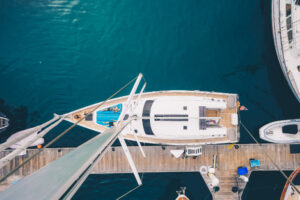
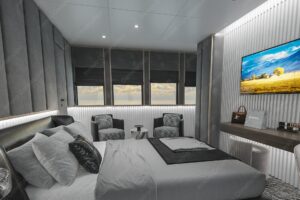
InnovoYacht | Athens, Peraeus, Greece
Designing with a pc software
Crafting the Υacht interior Renovation
In our yacht design process, we employ a special suite of software, a comprehensive set of tools for hull design, analysis, and construction. Utilizing the software, we swiftly generate an initial hull model and conduct essential hydrostatics, stability, and performance assessments to identify areas for refinement.
This computer-generated model enables us to iterate and enhance the design rapidly in the early stages, allowing for adjustments before finalization or easy modifications later in the process. Without such accessible computer modeling tools, the nuanced improvements we strive for would seldom be pursued, even with ample resources.
Additionally, there are numerous other advantages. For instance, the computer-generated model facilitates for Υacht interior Renovation ensuring that the surfaces are constructible, simplifying the construction of metal or plywood hulls.
Testing the Design
With the digital model of the hull and superstructure already established, creating a scaled-down physical model for towing tank tests or validating the yacht’s aesthetics and features in three dimensions is straightforward.
Constructing the Υacht interior Renovation
A significant advantage of digitally generating the hull model is the ability to also create the vessel’s structure computationally and precut it using computer-guided laser or plasma cutting. In the case of a GRP vessel, the mold can be crafted using a computer-guided router.
Through this process, after detailing the hull plating and structure for Υacht interior Renovation, the components are efficiently arranged on available plate sizes. The finalized plate layouts are then transmitted to the metal cutters, typically via email, enabling them to commence work promptly. Upon completion, the cutters produce a “boat kit” ready to be shipped to the desired location.
The Cost Savings
In a production setting, employing NC cutting for metal boat construction typically reduces hull fabrication labor by around 35%. The labor savings are even more substantial for amateur owner-builders. Lofting and templating for frame and plate patterns are eliminated, alleviating concerns about construction procedures. Additionally, NC cutting ensures an extremely precise fit, reducing distortion during welding for metal hulls for each Υacht interior Renovation.
For construction using materials like GRP, NC cutting nearly eliminates the labor needed for lofting and mold construction. A complete hull and superstructure mold can be carved directly from the computer-generated model using a five-axis NC router, minimizing tooling labor. Furthermore, pre-cutting glass fiber or carbon fiber cloth, particularly with ‘pre-preg’ cloth, streamlines the process, offsetting the initial cost of computer modeling development with improved efficiency.
InnovoYacht | Athens, Peraeus, Greece
Integration of solar energy usage into yacht design
For those who cherish long sailing expeditions and evenings spent at anchor, they understand that the foremost challenge to address revolves around conserving electrical power. This conservation is paramount for the smooth operation of virtually all onboard yacht equipment, ranging from electronic instruments to plumbing and from the electrical system to the basic nighttime lighting of the yacht’s cockpit, cabins, and seating areas.
Our company
Our company designs your yacht’s power supply with solar energy.
After careful consideration of battery quantity and type, as well as preferences regarding charging systems tailored to individual needs, attention can be turned to managing onboard consumption effectively. This management varies depending on the habits and number of occupants aboard.
What remains certain for Υacht interior Renovation is that technological advancements have significantly expanded the possibilities for reducing consumption over recent years.
The proliferation of countless devices fueled by solar cells has facilitated this, along with harnessing the Sun’s warmth, which can effectively enhance solar panel efficiency. From the shower to charging devices like phones and tablets. From lighting to cameras, numerous opportunities exist to conserve the precious energy stored in batteries without sacrificing comfort or entertainment. Sometimes, a touch of creativity proves invaluable.
The initial step focuses on water conservation: those who opt to install a foot pump alongside traditional onboard plumbing conserve both the energy required to operate a conventional 12 V pump and the precious water supply.
Accessible to all, this modification not only promotes judicious water usage but also serves as an emergency backup in the event of primary system electrical failures.
Continuing with the water theme, the adoption of solar-powered showers—perhaps already filled dockside to preserve onboard reserves—eliminates the need for the boiler. And has become commonplace for many sailors. These showers, typically constructed from PVC for easy folding when not in use, are available in various sizes (10, 15, and 20 liters), sufficient for multiple showers. Equipped with a hose and nozzle, they prove highly practical when hung on a roll bar. Here’s an example where water cascades down.
Other models also offer the option to pressurize water using a small equipped pump.
Desining the yacht lighting
When it comes to desining the yacht lighting, solar energy takes the lead. All onboard lights, of which there are many, can easily be set aside in favor of alternative options readily available on the market. Rechargeable lamps, hung from the lifeline wire during the day, provide ample and free illumination onboard as the sun sets. Alternatively, battery-powered LED lights, powered by basic AA batteries, offer equally valid alternatives and can be placed anywhere.
Numerous yacht owners have already replaced their below-deck lighting systems with solar-powered ones. Particularly since they require no wiring or bulb replacements, thus avoiding issues related to oxidation and failures.
Solar energy also aids in charging devices, with a plethora of options available on the market. Phones and tablets can be conveniently connected to solar power supplies. Which not only ensure the functionality of essential communication tools but also serve as excellent power banks. Additionally, they can be connected to 12 V devices installed onboard.
For below-deck comfort during warmer months (and adequate ventilation during colder months), modern solar cell-powered ventilators incur zero energy consumption.
In conclusion, the utilization of such a natural energy source as solar power now extends to navigation yacht equipment, such as Raymarine’s Tacktick wireless system, powered by solar cells.
Technology offers limitless possibilities for implementing onboard energy supplies and Υacht interior Renovation. With free solar energy, allowing each individual to make choices based on their specific needs.
InnovoYacht integrate the solar energy usage into yacht design.
InnovoYacht | Athens, Peraeus, Greece

